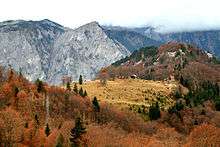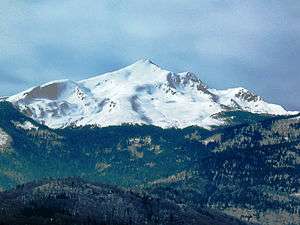Geography of Kosovo
 | |
| Continent | Europe |
|---|---|
| Region | Balkans |
| Coordinates | 42°36′00″N 20°51′00″E / 42.6000°N 20.8500°E |
| Area | Ranked 169th |
| • Total | 10,887 km2 (4,203 sq mi) |
| • Land | 99% |
| • Water | 1% |
| Borders | |
| Highest point |
Gjeravica, 2,656 m (8,714 ft) |
| Lowest point |
White Drin, 297 m (974 ft) |
| Longest river |
White Drin, 122 km (76 mi) |
| Largest lake |
Lake Gazivoda 9.2 km2 (4 sq mi) |
| Climate | Continental |
| Terrain | Mountainous |
| Natural Resources | nickel, lead, zinc, magnesium, lignite, kaolin, chrome, bauxite |
Kosovo is a landlocked country situated in Southeastern Europe, in the center of Balkan Peninsula. With an area of 10,908 km2 (4,212 sq mi), it is one of the smallest countries in Europe by area, but one of the most densely populated, with a population of 1,859,203 (2014 estimate) inhabitants (159/km2).
Considering its small size, Kosovo has a great variety of topographical features. It is surrounded by mountains: the Sharr Mountains are located in the south and southeast, bordering Macedonia, while the Kopaonik Mountains rise in the north. The southwest borders with Montenegro and Albania are also mountainous, and are home to the country's highest peak, Gjeravica, 2,656 m (8,714 ft) high. The central region is mainly hilly, but two large plains spread over Kosovo's west and east, respectively, Metohija plain and Kosovo plain.[1]
In the terms of hydrography, Kosovo has limited water resources. The main rivers in the country are the White Drin, running towards the Adriatic Sea, the South Morava in the Goljak area, and Ibar in the north. Sitnica, a tributary of Ibar, is the longest river lying completely within Kosovo. There are several small natural lakes but the country's most important lakes are artificial. The biggest lakes are Gazivoda, Radonjić, Batlava and Badovac. Kosovo also does have a large number of karst springs, thermal and mineral water springs.[2]
Area and boundaries
Kosovo is in the central part of the Western Balkans, Southeastern Europe and it borders Albania to the southwest, Macedonia to the southeast, Montenegro to the west, and Central Serbia to the north and east. It lies between latitudes 42° and 43° N, and longitudes 20° and 22° E.[3]

The total surface of the territory of Kosovo is 10,908 km2 (4,212 sq mi), making it the 169th largest country in the world,[3] with a border length as follows:
| Length of borders of Kosovo .[4] | |||
|---|---|---|---|
| Country | Length | ||
| Albania | 113.551 km (70.557 mi) | ||
| Republic of Macedonia | 170.772 km (106.113 mi) | ||
| Montenegro | 79.165 km (49.191 mi) | ||
| Serbia | 380.068 km (236.163 mi) | ||
| Total | 743.556 km (462.024 mi) | ||
Elevation extremes:
- highest point: Gjeravica/Đeravica 2,656 m (8,714 ft)
- lowest point: White Drin River 297 m (974 ft)
Topography


Although Kosovo has relatively small territory it has a very varied relief. Framed along its borders by high mountain ranges, such as Sharr Mountains to the south and southeast, Prokletije to the west, Kopaonik to the north and Goljak to the east, Kosovo's relief is clearly defined by two main plains in the inner part, Dukagjini to the south-west and Kosovo plain to the north-eastern part. Between Dukagjini and Kosovo plains, in the center of the country, is located Drenica Valley, a smaller hilly region surrounded by Čičavica mountains to the northeast and Kozmač to the southwest. There are also several other small valleys like Anamorava, Podujevo valley, Ibar Valley, etc.
Sharr mountain range
The Šar Mountains are located in the south and south-east of the country, bordering the Republic of Macedonia and Albania. With an area of 1100 km2, they represent approximately 1/10 part of total Kosovo territory.[5] The mountains border the Kosovo Plain to the north-east through the valley of the River Lepenci while in the north-west Lumëbardh of Prizren/Prizrenska Bistrica river defines the boundary with Dukagjini/Metohija Valley. Sharr mountain range extends to Macedonia in southern part and also to Albania in south-west.

Sharr mountains are one of the highest and ruggedest mountain ranges in the Balkans. In Kosovo's part officially the highest point is Luboten peak 2498 m above the sea level. Even though still not officially, after the border demarcation between Kosovo and Macedonia, Rudoka e Madhe/Velika Rudoka peak with 2658m, is the highest, not only in the Sharr mountain but in the whole Kosovo.
Regarding floristic aspect the region represent a treasure of plant species where a large number of endemic and relict plant species are present, including rare and endangered plant species. So far in these mountains have been identified 2,000 species of plants and 68 plant communities. Sharr territory with different biotopes is very rich in fauna aspect. Due to the ornito-faunistic richness, the Shar Mountains are evidenced in international lists as important ornito-faunistic region(IBA-Region).[6]
In 1986 an area of 390 km² or 35.4% of the total area of the mountain stretching in Kosovo side was declared as National Park.[7]
Due to the appropriate configuration, quality and the duration of the snow cover in the area, tourism in this region has developed regarding winter sport activities but also in summer. The region is known most for the skiing resorts, with Brezovica and Prevalac as the main tourist centers.
Accursed Mountains
The Accursed Mountains (Albanian: Bjeshkët e Namuna), in Kosovo are a continuation of the Albanian Alps from northern Albania and eastern Montenegro. This massif constitutes the south-west and western suburb of Kosovo, which rises up vertically from the Dukagjin Plain (490m) in the east. Accursed Mountains start at northwest of Kosovo, in the area of upper Ibar river valley near the city of Mitrovica, just after Mali i Thate (1,750 m) massif that encircles Dukagjin basin from the north and northwest. It continues to Albania and Montenegro in the south and south-west.[8]


Accursed Mountains region is considered to be the most inaccessible mountain range in Europe and the wildest range on the Balkan Peninsula which is best described in their name. They encompass areas of unique landscape with high craggy peaks, alpine lakes, caves, waterfalls and deep river canyons such as Rugova Canyon 1,000 m (3,281 ft) deep and 25 km (16 mi) long.[9]
The highest peak of the range in Kosovo is Gjeravica, 2,656 m (8,714 ft) above sea level, which is also Kosovo's highest peak.
Regarding biodiversity, the area represents one of the most important regions in Europe. In terms of Flora the regions is very rich and diverse with alpine and sub-alpine mountain habitats, alpine meadows and pastures with species rich vegetation, and large forest complexes including primeval treestands of the endemic Balkan pine and Bosnian pine. The region is also home for a large number of fauna species, which includes endangered species of the common European importance, like the brown bear, wolf and Balkan lynx. [10]
Kopaonik Mountain Range

Kopaonik is a mountain range in the northern part of Kosovo which extends further into central Serbia. Ibar river borders it to the west and Llap river to the east. Its highest point is Pančić's Peak rising up to 2017 m above sea level and it's located in the administrative-autonomous border line with Serbia.
Kopaonik mountains are characterized with mineral wealth, especially with lead and zinc, making it one of the richest regions in Europe. This is due to the diversity of its geological-tectonic structure, particularly with the new vulcanization during Tertiary Period. The source of lead and zinc in Trepca is the largest skarno-hydrothermal source across Europe.[11]
Plains
There are two main plains in Kosovo. The Metohija basin is a semi-karst field that lies in the southwestern part of Kosovo, covering 35% (3,891 km2) of country's total area. It is about 60 km long and 23 km wide at its broadest point and its average altitude is 450 m (1,476 ft) above sea level. It is surrounded by high mountain ranges of Bjeshket e Nemuna in the western part, Pashtrik in the southwest, the Sharr Mountains in the south and southeast. In the eastern part it borders the hilly region of Drenica which divides it from Kosovo plain. White Drin is the main river that flows in this region,
Dukagjini region is highly influenced by the hot air masses that come from the Adriatic Sea through the valley of White Drin river. The average temperatures during the winter range from 0.5°C to 22.8°C. Average annual precipitation of this climatic area is 700 mm per year. The winter is characterized by heavy snowfalls.[12]
Rugova Valley and Canyon
One of Kosovo's most prominent geological features is the Rugova Canyon of the Accursed Mountains. The 25 km (16 mi) long canyon near the border with Montenegro was formed by the flow of the Pećka Bistrica. The canyon was declared a Protected National Monument in 1988, and will be included in a proposed "Balkan Peace Park", approved by the Kosovo Parliament in 2003.
Gadime Cave
Gadime Cave is a cave composed of Paleozoic marble, located in the village of Donje Gadimje on the eastern side of the Kosovo Valley. The northern passage contains displays of aragonite speleothems in a variety of rare formations.[13][14]
Bodies of water
Although Kosovo is landlocked, there are several notable rivers and lakes within its borders. The main rivers are the White Drin, running towards the Adriatic Sea, with the Erenik among its tributaries, the Sitnica, the South Morava in the Goljak area, and Ibar in the north. The main lakes are Gazivoda Lake (380 million m³) in the north-western part, Radoniq lake (113 million m³) in the south-west part, Batlava Lake (40 million m³) and Badovc Lake (26 million m³) in the north-east part. Other smaller scenic lakes include Zemra Lake, Đeravica Lake and Liqenat Lake. Kosovo is also home to the following waterfalls:
- The 25 metres (82 ft) Drin Waterfall is located at the mouth of the White Drin River.
- The Mirusha Waterfalls are a series of falls on the Miruša River (a tributary of the Drin) in the municipality of Mališevo in western Kosovo, on the Metohija region.
In the Bifurcation of Nerodimka river, it contains the only example in Europe (and one of only two in the world) where a river divides with the resultant water flows ending up in different seas (the Black Sea and the Aegean)
Climate
Kosovo is located between the Mediterranean Sea and mountainous regions of Southeast Europe, on the Balkan Peninsula. This geographic location gives the country its large annual temperature range. Summer temperature highs can reach +30 °C (86 °F), winter's temperatures as low as −10 °C (14 °F).[15] According to the Strahler classification map the climate in Kosovo is considered moist continental.[16] The country experiences warm summers and cold and snowy winters.
See also
References
- ↑ Kosovo Travel Guid
- ↑ Independent Commission for Mines and Minerals of Kosovo
- 1 2 , CIA - The World Factbook
- ↑
- ↑ http://www.parksdinarides.org/en/kosovo/sharri
- ↑ http://www.ammk-rks.net/repository/docs/Vlerat_e_trashegimis_natyrore_te_Kosoves.pdf
- ↑ http://www.bth.se/fou/cuppsats.nsf/all/3661a8471db7e401c12573ec003926a0/$file/Thesis%20Work-IM%20final(2).pdf
- ↑ http://www.researchgate.net/profile/Veselaj_Zeqir/publication/261805123_Bjeshkt_e_Nemuna-_perla_natyrore_e_Kosovs/links/02e7e5358c29e8bee6000000.pdf
- ↑ http://www.tripadvisor.com/Attraction_Review-g304082-d1167653-Reviews-Rugova_Canyon-Kosovo.html
- ↑ http://www.unep.at/documents_unep/Balkan_Feasibility_Studies/Prokletije_25-10-2010.pdf
- ↑ http://www.trepca.net/histori/020113-shala-bajgores-ne-veshtrimin-historik.htm
- ↑ http://www.kosovo-mining.org/kosovoweb/al/kosovo/climate.html
- ↑ Mermerna Pecina, Tony Oldham, 2002
- ↑ Around Kosovo: It's Better to See it Once Than Hear About it 100 Times, Valerii Petrushka
- ↑ Geography
- ↑ Strahler & Strahler. (2006).Introducing Physical Geography, Boston:John Wiley & Sons Inc.
External links
-
 Wikimedia Atlas of Kosovo
Wikimedia Atlas of Kosovo -
 Kosovo travel guide from Wikivoyage
Kosovo travel guide from Wikivoyage - Visit Kosovo - Tourism Website
- Kosovo Caves Gadimje